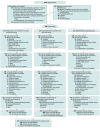Effect of Out-of-Hospital Tranexamic Acid vs Placebo on 6-Month Functional Neurologic Outcomes in Patients With Moderate or Severe Traumatic Brain Injury
- PMID: 32897344
- PMCID: PMC7489866
- DOI: 10.1001/jama.2020.8958
Effect of Out-of-Hospital Tranexamic Acid vs Placebo on 6-Month Functional Neurologic Outcomes in Patients With Moderate or Severe Traumatic Brain Injury
Erratum in
-
Error in Table.JAMA. 2020 Oct 27;324(16):1683. doi: 10.1001/jama.2020.20143. JAMA. 2020. PMID: 33107924 Free PMC article. No abstract available.
Abstract
Importance: Traumatic brain injury (TBI) is the leading cause of death and disability due to trauma. Early administration of tranexamic acid may benefit patients with TBI.
Objective: To determine whether tranexamic acid treatment initiated in the out-of-hospital setting within 2 hours of injury improves neurologic outcome in patients with moderate or severe TBI.
Design, setting, and participants: Multicenter, double-blinded, randomized clinical trial at 20 trauma centers and 39 emergency medical services agencies in the US and Canada from May 2015 to November 2017. Eligible participants (N = 1280) included out-of-hospital patients with TBI aged 15 years or older with Glasgow Coma Scale score of 12 or less and systolic blood pressure of 90 mm Hg or higher.
Interventions: Three interventions were evaluated, with treatment initiated within 2 hours of TBI: out-of-hospital tranexamic acid (1 g) bolus and in-hospital tranexamic acid (1 g) 8-hour infusion (bolus maintenance group; n = 312), out-of-hospital tranexamic acid (2 g) bolus and in-hospital placebo 8-hour infusion (bolus only group; n = 345), and out-of-hospital placebo bolus and in-hospital placebo 8-hour infusion (placebo group; n = 309).
Main outcomes and measures: The primary outcome was favorable neurologic function at 6 months (Glasgow Outcome Scale-Extended score >4 [moderate disability or good recovery]) in the combined tranexamic acid group vs the placebo group. Asymmetric significance thresholds were set at 0.1 for benefit and 0.025 for harm. There were 18 secondary end points, of which 5 are reported in this article: 28-day mortality, 6-month Disability Rating Scale score (range, 0 [no disability] to 30 [death]), progression of intracranial hemorrhage, incidence of seizures, and incidence of thromboembolic events.
Results: Among 1063 participants, a study drug was not administered to 96 randomized participants and 1 participant was excluded, resulting in 966 participants in the analysis population (mean age, 42 years; 255 [74%] male participants; mean Glasgow Coma Scale score, 8). Of these participants, 819 (84.8%) were available for primary outcome analysis at 6-month follow-up. The primary outcome occurred in 65% of patients in the tranexamic acid groups vs 62% in the placebo group (difference, 3.5%; [90% 1-sided confidence limit for benefit, -0.9%]; P = .16; [97.5% 1-sided confidence limit for harm, 10.2%]; P = .84). There was no statistically significant difference in 28-day mortality between the tranexamic acid groups vs the placebo group (14% vs 17%; difference, -2.9% [95% CI, -7.9% to 2.1%]; P = .26), 6-month Disability Rating Scale score (6.8 vs 7.6; difference, -0.9 [95% CI, -2.5 to 0.7]; P = .29), or progression of intracranial hemorrhage (16% vs 20%; difference, -5.4% [95% CI, -12.8% to 2.1%]; P = .16).
Conclusions and relevance: Among patients with moderate to severe TBI, out-of-hospital tranexamic acid administration within 2 hours of injury compared with placebo did not significantly improve 6-month neurologic outcome as measured by the Glasgow Outcome Scale-Extended.
Trial registration: ClinicalTrials.gov Identifier: NCT01990768.
Conflict of interest statement
Figures


Comment in
-
Out-of-Hospital Tranexamic Acid for Traumatic Brain Injury.JAMA. 2020 Sep 8;324(10):946-947. doi: 10.1001/jama.2020.9244. JAMA. 2020. PMID: 32897330 No abstract available.
References
-
- Feigin VL, Nichols E, Alam T, et al. ; GBD 2016 Neurology Collaborators . Global, regional, and national burden of neurological disorders, 1990-2016: a systematic analysis for the Global Burden of Disease Study 2016. Lancet Neurol. 2019;18(5):459-480. doi:10.1016/S1474-4422(18)30499-X - DOI - PMC - PubMed
-
- Peterson AB, Xu L, Daugherty J, Breiding MJ. Surveillance Report of Traumatic Brain Injury-related Emergency Department Visits, Hospitalizations, and Deaths—United States, 2014. Centers for Disease Control and Prevention, US Dept of Health and Human Services; 2019.
Publication types
MeSH terms
Substances
Associated data
Grants and funding
LinkOut - more resources
Full Text Sources
Medical

